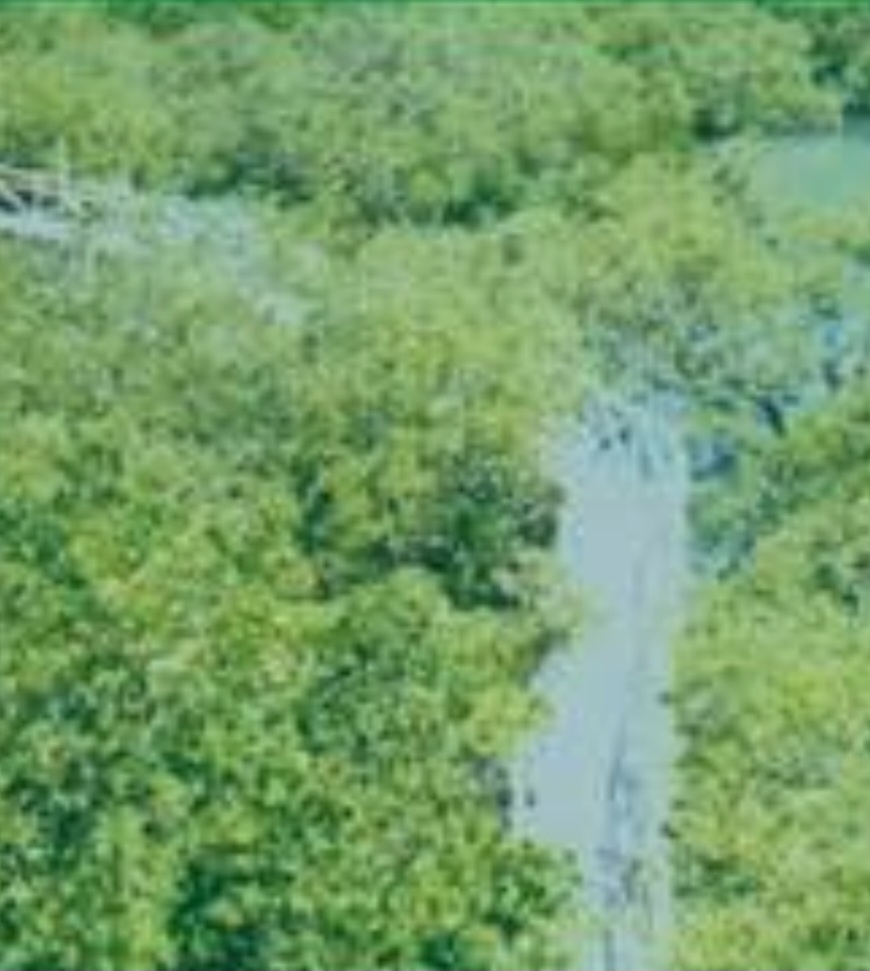Between Land and Sea:
The Untold Story
of Mangrove Ecosystems
by Jet Fellow
I have been living on the shoreline for most of my life, where the air is salty, the sunsets are golden, and the sound of waves is both calming and frightening. From my window, I see the sea breathing in and out, pushing tides closer to our homes. But what truly stands as our shield, quiet yet powerful, is the mangrove forest that lines the edge of the coast.
The mangroves may look ordinary at first glance … twisted roots, muddy ground, and thick green leaves … but to us, they are extraordinary guardians. When storms arrive with furious winds and monstrous waves, the mangroves hold the soil tightly with their strong, tangled roots. They block the surging water from swallowing our land. Without them, our homes would be washed away, and families would be exposed to vulnerability.
As a child, I often played among the mangroves. Their roots became my playground, their shadows my hiding place. I remember the cool, damp soil between my toes and the smell of wet earth after rain. Back then, I didn’t understand their importance. I only knew they were part of the scenery. But as I grew older, I began to see how these humble trees carried the weight of our survival.
The mangrove forest is not only a shield for people, but also a haven for creatures. Colorful crabs crawl sideways, hiding in burrows (mud tunnels). Small fish swim through the shallow water, hiding among the roots before heading to the open sea. Birds with bright feathers perch on branches, their calls filling the morning with music. Every leaf, every root, and every drop of water forms a delicate web of life.
What makes mangroves truly special is their ability to live between two worlds … land and sea. They grow where few plants dare to survive, in salty water and shifting tides. Their leaves are tough, their roots are patient, and their trunks are unyielding. They are living symbols of resilience.
But today, these ecosystems are in danger. Many mangrove forests are cut down for fishponds, buildings, or firewood. Once they are gone, the shoreline becomes naked and weak. The waves creep closer, the soil erodes, and the fish disappear. It is heartbreaking to see places where mangroves once stood tall now reduced to empty, muddy fields.
Here in my community, we have learned through experience that protecting mangroves means protecting ourselves. I still remember many strong typhoons that hit our town. The winds roared like angry beasts, and the waves were tall and merciless. Yet, the mangroves stood like soldiers, absorbing the impact of the storm. Many lives and homes were spared because of their strength. That day, I realized how blessed we are to live with these natural guardians.
Beyond protection, mangroves give us so much more. They provide wood for shelter, clean the air by storing carbon, and even keep the water fresh for marine life. They are natural engineers, architects of balance between people and nature. Their roots are like nets catching soil, keeping the ocean clear. Their leaves fall and decay, becoming food for countless tiny creatures that launch the cycle of life.
The mangroves are also storytellers. They tell us of patience, standing firm despite harsh tides. They teach us about generosity, giving without asking for anything in return. And they remind us of harmony, showing that land and sea, people and nature, can coexist if treated with respect.
Now, when I walk by the shoreline, I no longer see mangroves as ordinary trees. I see them as guardians, neighbors, and friends. I feel a sense of duty to protect them the way they protect us. Planting new seedlings has become a community effort, where young and old gather with muddy hands and hopeful hearts. Every seed we plant is a promise that the next generation will inherit the same protection we have today.
To live between land and sea is both a gift and a challenge. The ocean can be both generous and cruel, but with the mangroves by our side, we find strength. Their story is often untold, hidden in the shadows of larger forests and mountains. Yet, it is a story worth sharing … a story of resilience, protection, and life.
So, when I look at the horizon, where the sky meets the water, I whisper a quiet thank you to the mangroves. They are not just trees. They are living shields, gentle teachers, and steadfast companions in our journey between land and sea. ###
Note: Jet Fellow is the pseudonym of Rommel Dominguez Marchan of Carigara, Leyte

